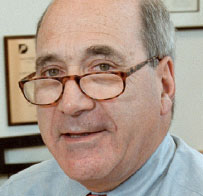David Livingston

David Livingston is Deputy Director of the Dana-Farber/Harvard Cancer Center; Chief of the Charles A. Dana Division of Human Cancer Genetics, and the Emil Frei Professor of Genetics and Medicine at Harvard Medical School. From 1996 to 2000, he served as Chairman of the Executive Committee for Research at the Dana-Farber Cancer Institute, leading the senior faculty group that oversees all aspects of the Institute's research program. He reassumed that post in 2005 and has been in it since that time. Dr. Livingston has been a Harvard faculty member continuously since 1973. Dr. Livingston received an A.B. cum laude from Harvard College in 1961, an M.D., magna cum laude, from Tufts University School of Medicine in 1965, and served his internship and residency in internal medicine at the Peter Bent Brigham Hospital (now Brigham and Women's Hospital) in Boston. In 1967, he became a Research Associate at the National Cancer Institute (NCI) in molecular biology and biochemistry; he continued his work as a Research Fellow in Biological Chemistry at Harvard Medical School in 1969. Dr. Livingston returned to NCI in 1971 as a Senior Staff Fellow where he began his career in cancer research. He was recruited to Dana-Farber (then the Children's Cancer Research Foundation) in 1973. Dr. Livingston is an internationally recognized expert on genes that regulate cell growth in the body -- genes that, when they go awry, can lead to cancer. These genes are called oncogenes and tumor suppressor genes. Through his research, Dr. Livingston has uncovered detailed biochemical steps required to initiate and maintain the transformation of these cells into tumor cells. His focus is on the regulatory controls of signal transduction -- the smooth and coordinated flow of special chemical signals from the surrounding environment to the cell, where it is transduced into specific commands that tell cells whether or not to grow -- and their role in cancer development. In recent years, his work has centered on those key molecular steps that trigger the development of breast and ovarian cancer. Dr. Livingston is the recipient of numerous awards and honors. He has been elected to the Institute of Medicine of the National Academy of Sciences, the National Academy of Sciences, itself, and the American Academy of Arts and Sciences. He sits on multiple editorial boards, the science advisory boards of other research institutions, and is a member of the Association of American Physicians, the American Society for Clinical Investigation, the American Society for Microbiology, and the American Academy of Microbiology. He is also a Foreign Associate of the European Molecular Biology Organization and serves as Vice Chair of the Board of the Damon Runyan Cancer Research Foundation. Dr. Livingston has authored more than195 scientific publications.
Linkages Between Genome Disorder and Breast Cancer Development.
Approximately 3-4% of all women in Europe and America who develop breast cancer each year do so by inheriting a mutant copy of a gene that normally operates to suppress breast cancer development. Several such genes have been identified and are under active investigation. Among them, two, BRCA1 and 2, are the best studied and are, collectively, responsible for approximately 60% of these inherited cases. Germ line mutant BRCA1 and 2 genes also elicit high frequency ovarian cancer development.
Interestingly, much of this collection of inherited, breast cancer- suppressing genes operates to promote the maintenance of a stable and integral genome. Indeed, the majority of the genome integrity maintenance/ breast cancer suppressor genes in this group function in a coordinated way to support cellular responses to the development of double strand genomic breaks (DSB). More specifically, they do so by participating in the process that repairs these lesions in an error-free manor, so called homologous recombination (HR). Thus, insuring the proper repair of these DNA lesions, which develop normally in most, if not all, replicating cells, is a breast cancer- suppressing process.
Recently, evidence has emerged showing that at least some of these genes encode proteins that participate in cellular responses to yet other forms of genome damage, as well as in the processes which insure that breast epithelial cells maintain a standard, modal chromosome number. There is also evidence which suggests a role for some of these events in breast cancer suppression.
What has been particularly mysterious is why breast (and ovarian) cancer, in particular, as opposed to tumor development in other organs, is the prime outcome of BRCA1 - driven tumor development and the major clinical result of BRCA2 dysfunction. This subject will be discussed in some detail.





